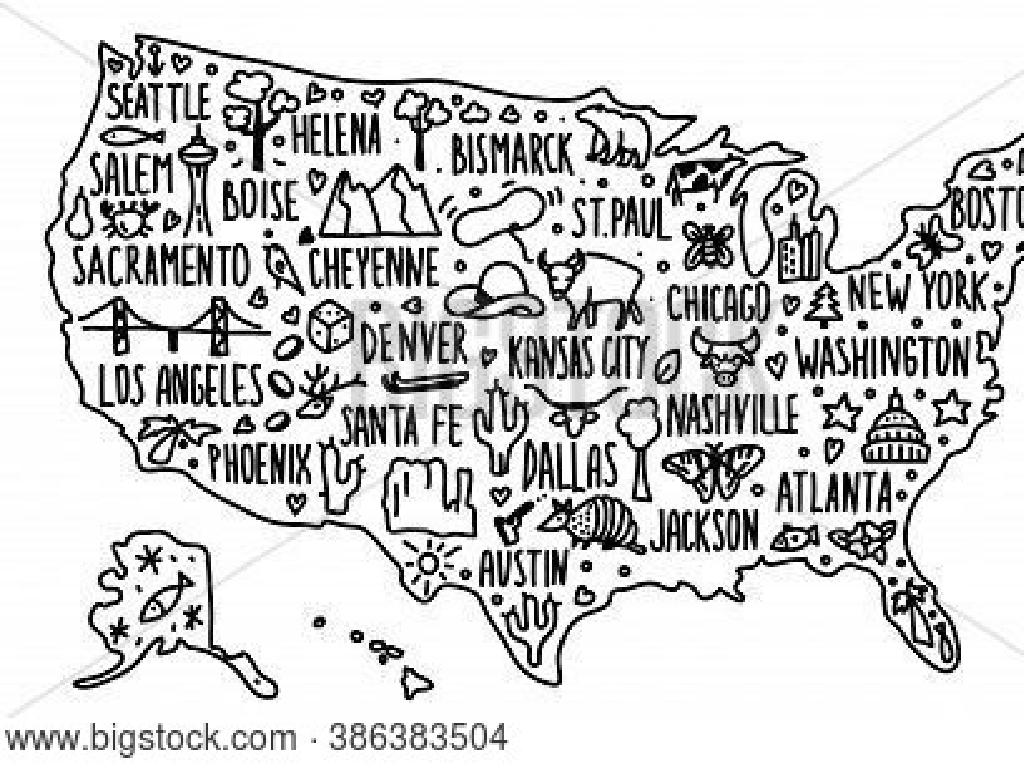Portuguese And Spanish Expeditions: Part I
Subject: Social studies
Grade: Eighth grade
Topic: Age Of Exploration
Please LOG IN to download the presentation. Access is available to registered users only.
View More Content
The Age of Exploration: Portugal and Spain Lead the Way
– Unveiling the Age of Exploration
– Motivations for maritime expeditions
– Driven by ‘God, Glory, and Gold’: spreading Christianity, gaining fame, and seeking wealth.
– Portugal’s pioneering explorers
– Prince Henry the Navigator’s role, Vasco da Gama’s voyage to India.
– Spain’s quest for new routes
– Columbus’s voyage to the Americas, Treaty of Tordesillas.
|
This slide introduces students to the Age of Exploration, a pivotal period in history when European powers began to explore the world’s oceans. Emphasize the three main motives of exploration: spreading Christianity (God), the pursuit of national prestige (Glory), and the search for new trade routes and wealth (Gold). Highlight Portugal’s significant contributions with figures like Prince Henry and Vasco da Gama, who found a sea route to India. Discuss Spain’s role, including Columbus’s voyages and the impact of the Treaty of Tordesillas on global exploration. Encourage students to consider the lasting effects of these expeditions on world history.
Motivations Behind Portuguese and Spanish Expeditions
– Seeking new trade routes
– To bypass intermediaries for direct Asia trade
– Quest for gold and spices
– Attracted by the wealth of the East, explorers sought precious metals and spices
– Innovations in navigation
– Astrolabe and compass use improved long-distance sea travel
– Religious and political drives
– Spread Christianity and expand empires were key goals
|
This slide aims to explain the various reasons that propelled the Portuguese and Spanish expeditions during the Age of Exploration. The desire for new trade routes was primarily to gain direct access to the lucrative Asian spice trade, avoiding middlemen and reducing costs. The pursuit of gold, spices, and other natural resources was driven by the potential wealth these commodities represented. Advancements in navigation technology, such as the astrolabe and magnetic compass, made it possible to travel further with greater precision. Finally, religious zeal to spread Christianity and political ambitions to expand their empires were powerful motivators for these explorations. Discuss how these motivations led to the voyages of explorers like Vasco da Gama and Christopher Columbus, setting the stage for the global interactions that followed.
Portugal Leads the Way in Exploration
– Prince Henry’s navigation advances
– Established a navigation school and funded voyages
– Caravel: A game-changing ship
– The caravel, with its agility and speed, allowed longer voyages
– Portugal’s African coast expeditions
– Explored African coasts, setting up trade and claiming territories
– Dias’ milestone: Cape of Good Hope
– First to sail around the southern tip of Africa in 1488
|
This slide highlights the pivotal role Portugal played in the Age of Exploration, led by visionaries like Prince Henry the Navigator. His contributions to navigation and his support for exploration were instrumental in advancing maritime knowledge. The development of the caravel, a ship designed for long voyages, was crucial for the Portuguese to travel further along the African coast, leading to the establishment of new trade routes and territorial claims. Bartolomeu Dias’ successful rounding of the Cape of Good Hope marked a significant milestone in maritime exploration, paving the way for a sea route to Asia. Encourage students to discuss the impact of these advancements on global trade and cultural exchanges.
Spain Joins the Race of Exploration
– Spanish monarchy backs exploration
– Monarchs like Queen Isabella funded voyages for glory and wealth.
– Columbus’s 1492 voyage
– Columbus reached the Americas, believing it was Asia.
– Treaty of Tordesillas division
– Spain and Portugal divided the New World in 1494.
– Impact of Columbus’s discoveries
– Europe gained wealth and knowledge; indigenous faced conquest and disease.
|
This slide explores the pivotal role of the Spanish monarchy in the Age of Exploration, particularly their sponsorship of Christopher Columbus’s 1492 voyage, which led to the encounter with the Americas. Discuss the Treaty of Tordesillas, which was an agreement between Spain and Portugal to divide the newly discovered lands outside Europe. Highlight the profound consequences of Columbus’s voyages on both Europe and the indigenous populations, including the transfer of wealth, expansion of European knowledge, and the devastating impact of conquest and disease on native peoples. Encourage students to consider the motives of exploration and the long-term effects of these historic events.
Navigational Breakthroughs: Age of Exploration
– Instruments enabling exploration
– Tools like the astrolabe and compass were crucial for explorers to navigate the seas.
– Astrolabe and compass usage
– Astrolabe measured celestial bodies’ positions; compass showed direction.
– Significance of maps and charts
– Maps and sea charts provided detailed coastal outlines and sea routes.
– Impact on maritime navigation
– These tools increased safety and success rates of long sea voyages.
|
This slide aims to highlight the key navigational tools that were instrumental during the Age of Exploration. Emphasize how the astrolabe allowed sailors to determine latitude by measuring the angle of stars above the horizon, and how the magnetic compass provided a reliable sense of direction, which was not influenced by the position of the sun or stars. Discuss the importance of accurate maps and sea charts in planning routes and avoiding hazards, contributing to the success of maritime expeditions. These advancements in navigation not only made it possible to explore unknown territories but also played a significant role in the expansion of trade and the establishment of new trade routes.
Life on the Ship: Age of Exploration
– Crew members’ daily routines
– Roles varied from navigation to maintenance, with strict schedules.
– Challenges of long voyages
– Storms, scurvy, and navigation issues were common hardships.
– Diet and health on board
– Meals were often dry biscuits, salted meat, and beer or water.
– Hygiene practices at sea
– Limited fresh water meant infrequent bathing and laundry.
|
This slide aims to give students a glimpse into the daily life of sailors during the Age of Exploration. Discuss the structured daily routines of crew members, including their specific roles and the discipline required aboard a ship. Highlight the common challenges faced during long voyages, such as harsh weather conditions, diseases like scurvy due to vitamin C deficiency, and the difficulty of staying on course. Explain the typical diet on the ship, which was designed to prevent spoilage, and touch on the health issues that arose from nutritional deficiencies. Address the hygiene practices, or lack thereof, due to limited fresh water supplies, which led to unsanitary conditions and affected the overall health of the crew. Encourage students to consider how these factors influenced the experiences of explorers and the outcomes of their expeditions.
Consequences of Exploration
– The Columbian Exchange impact
– Vast transfer of goods, crops, and diseases between the Old and New Worlds
– Cultural impacts on societies
– Exchange led to cultural blending and changes in indigenous ways of life
– Start of European colonization
– European powers began to establish colonies, altering land ownership and governance
– Global economic transformations
|
This slide aims to highlight the major consequences that arose from the Age of Exploration, particularly focusing on the aftermath of the Portuguese and Spanish expeditions. The Columbian Exchange refers to the massive transfer of goods, including crops like potatoes and maize, as well as the unintended spread of diseases such as smallpox, which had profound effects on population and agriculture. Cultural impacts include the blending of European and indigenous cultures, leading to changes in language, religion, and social customs. The beginning of European colonization marked a significant shift in global power dynamics, with European nations establishing control over vast territories, which led to the exploitation of resources and indigenous peoples. Discuss the long-term economic changes, such as the rise of mercantilism and the global trade networks that still influence modern economies. Encourage students to consider both positive and negative outcomes of these historical events.
Class Activity: Explorers’ Roundtable
– Form groups and assign explorers
– Research explorer backgrounds
– Focus on reasons for exploring, life history
– Discuss journeys and discoveries
– Map the routes, examine the impacts
– Prepare for a class roundtable
– Share insights in a discussion format
|
This activity is designed to engage students with the Age of Exploration by having them step into the shoes of the era’s most famous explorers. Each group will delve into the life and expeditions of assigned explorers, such as Vasco da Gama, Christopher Columbus, or Ferdinand Magellan. They should research the historical context, the motivations for their voyages, the challenges they faced, and the outcomes of their discoveries. Encourage students to use a variety of sources for their research. The roundtable discussion will allow students to present their findings and debate the different aspects of their explorers’ journeys, fostering a deeper understanding of the explorers’ contributions and the global impact of their discoveries. Possible activities include creating explorer profiles, drawing maps of their routes, and discussing the long-term effects of their expeditions on the world.






